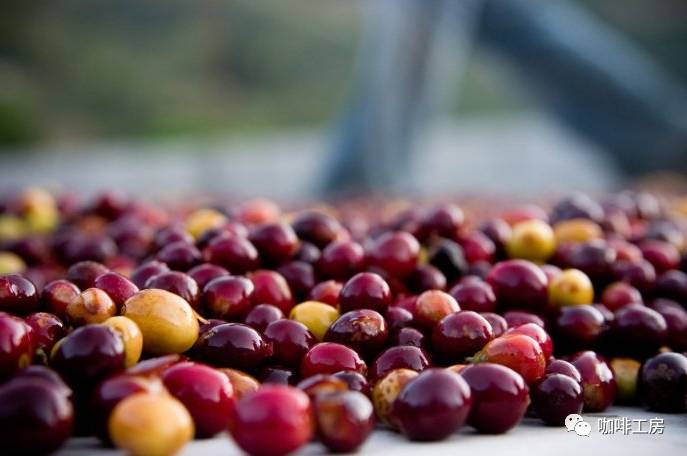Coffee lovers pay attention to the lack of genetic diversity or the extinction of Arabica coffee beans.

For professional baristas, please follow the coffee workshop (Wechat official account cafe_style)
Coffee beans are a bit like bananas.
Like the Cavendish banana, the only banana variety found on the shelves of most supermarkets in the world, the highest quality Arabica coffee beans have very low genetic diversity.
Experts predict that the evolution of the pathogen in the future will cause fatal damage to the Cavendish banana, and as it spreads rapidly around the world, the Cavendish banana will face extinction.
Arabica coffee beans grown commercially in most countries are derived from several seeds brought to Yemen from the African country Ethiopia centuries ago.
In the 1600s, the Dutch East India Company took them to Indonesia, where they moved to Europe and then to Latin America.
Raf Aerts, a researcher at the University of Leuven in Belgium, said the similarity between coffee beans and bananas is that the low genetic diversity in commercial cultivation means they cannot adapt to changes in the environment.
For a long time, banana growers have been involved in the battle for the survival of this fruit. In the case of Cavendish bananas, they are battling a fungal plague spread through Asian plantations. Coffee bean researchers and scientists worry that their coffee beans may suffer a similar fate.
Orphan crop
Most of the coffee beans grown in the world come from two major varieties, Arabica and Robusta. Arabica coffee beans are a more vulnerable plant, vulnerable to disease and drought, but they taste better and less bitter than robusta beans, which are mainly used to produce instant coffee.
However, in the past century, although almost every other food crop has been significantly improved through plant breeding, very little research has been done on coffee beans.
Timothy Schilling, chief executive and founder of World Coffee Research, a group funded by the coffee industry, says coffee beans are an orphan crop. It mainly grows in less developed countries without resources and funds.
As global demand for coffee is expected to double by 2050 and the amount of land available for production will be reduced, high-yielding coffee bean varieties that are resistant to disease and drought are crucial, industry experts say.
World Coffee Research recently created 46 hybrid varieties that are being tested. Before the establishment of World Coffee Research in 2012, Benoit Bertrand, now the organization's chief coffee bean breeder, was involved in the early wave of coffee bean hybrids in Latin America, which was released in 2010.
The new variety seems to be resistant to fungal coffee leaf rust and won taste testing competitions in Nicaragua and Costa Rica.
Wild gene
For plant breeders, the existence of wild genes is necessary to develop new varieties that can resist disease and drought. Wild coffee bean genes can be found in Ethiopia, and wild Arabica coffee beans grow in the remaining undisturbed forests.
However, these forests are disappearing at an alarming rate because of deforestation and logging, Aerts said. He added that Fidu's genetic integrity was being lost.
A team at the Royal Botanical Gardens is mapping the genes of hundreds of wild Arabica varieties in the Ethiopian forest. The team wants to use these wild varieties as a basis to create new varieties with more advantages.
However, Aaron Davis, senior research director of plant resources at the Royal Botanical Garden, said that so far, none of the new Arabica varieties being tested has been able to overcome the dry environment.
A temperature rise of 4 degrees Celsius in Ethiopia could reduce coffee bean growing areas by up to 60 percent by the end of the century, according to a new study from the Royal Botanical Garden.
Professor Sebsebe Demissew, a senior botanist at Addis Ababa University, said that since Ethiopia is the main natural warehouse for genetic diversity of Arabica coffee beans, what is happening there could have a long-term impact on global coffee cultivation.
Important Notice :
前街咖啡 FrontStreet Coffee has moved to new addredd:
FrontStreet Coffee Address: 315,Donghua East Road,GuangZhou
Tel:020 38364473
- Prev

In line with Coffee Tide 3.0 Gold Coffee cooperates with world-class coffee farms
For the exchange of professional baristas, please follow the Coffee Workshop (Wechat official account cafe_style) Gold Coffee Coff Photo / Gold Coffee provides celebrating the opening of Taipei Diding Store. Taiwan's second 50% discount Gold Coffee drink cooperates with world-class manors to go to dangerous places in person.
- Next

Austrian food importers and exporters aim at Chinese coffee market
Professional baristas Please follow the Coffee Workshop (Wechat official account cafe_style) according to a report in Austria's Tyrol Daily on September 20, Austria's Wedl company aims at the Chinese coffee market and will export its Bristot coffee products to 1000 Chinese Spumoni stores. Wedl is one of the top ten food importers and exporters in Austria, providing the catering industry with top quality fish,
Related
- What effect does Italian American coffee with filter paper have? Will coffee taste better if it is put on filter paper at the bottom of the powder bowl?
- What is the color difference in coffee beans? What are the characteristics of honey processed coffee beans? Why are the anaerobically treated coffee beans uneven in color?
- How does novice Xiaobai quickly get started and make coffee? Newbies learn to make coffee by hand and share the specific steps and process process!
- Costa tea has a shelf life of 100 years?! Expert: Unable to verify
- It's a huge uproar! American milk addition was rejected by Manner employees?!
- Mocha pot coffee bean recommendations| How fine and how much powder should be used for grinding? What parameter ratios do I need to use to make milk with Mocha pot coffee?
- What are the characteristics of the world's top ten coffee beans treated with Costa Rica honey? How to make black honey kadura from Tarazhu Pilon Processing Plant taste good?
- How to make deep-roasted coffee? What grinding water temperature does authentic Jamaica Blue Mountain No. 1 coffee use to brew it well?
- Selected high-grade rose summer coffee flavor tasting guide Why Panama rose summer has the aroma of flowers and fruits
- What equipment does a novice Xiaobai need to buy to learn to make coffee? Filter cup electronic scale bean grinder manual flushing pot purchase guide

